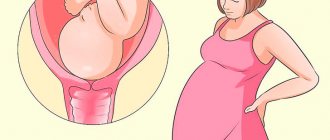The uterus is the main organ of the female reproductive system. With its help, a woman bears and gives birth to children. Due to weakening of the muscles, a pathology such as uterine prolapse can sometimes occur. The main causes of this disease include:
- hormonal imbalances;
- frequent childbirth;
- excessive physical activity.
If the process is at the initial stage, then conservative therapy, supporting corsets, and special uterine rings are used to restore women's health. In addition, specially designed exercises and a balanced diet help a lot. If the situation is critical, then patients are advised to undergo surgery for uterine prolapse.
General concept of omission
Uterine prolapse (prolapse) is the displacement or prolapse of the pelvic organs. In a normal position, it is located with a well-developed ligamentous apparatus and sufficient tone. Support for the organ is also provided by the abdominal muscles and pressure inside the abdominal cavity. If any parts of the system begin to function poorly, this leads to prolapse of the internal genital organs. Neglect of the disease leads to serious complications. Prolapse of the cervix is often caused by obesity, dystrophy, a tendency to constipation, the appearance of large fibroids, and hereditary factors. Often, elderly women suffer from this disease. To protect yourself from this pathology, you need to be attentive to your health and regularly visit a gynecologist.
- Uterine prolapse (symptoms and consequences, lifestyle)
- Uterine prolapse in older women: treatment, surgery
Complications after suturing the cervix during pregnancy
The main risks after surgery are the possible development of inflammation and the appearance of increased muscle tone of the uterus.
Inflammation can have different origins. In some cases, it is caused by an internal infection, and sometimes the body reacts in a similar way to the material of the thread that held the tissue of the cervix together. In this case, due to aseptic inflammation or allergies, a pregnant woman may observe discharge of different shades and consistency. A pregnant woman can avoid such troubles if she regularly visits her doctor, takes tests to monitor vaginal flora and carefully follows the rules of intimate hygiene.
By developing hypertonicity of the uterus, the female body can react to the contact of suture material and living tissue. In this case, mechanical irritation of the area of the cervix on which the operation was performed often occurs. This is what is associated with post-operative nagging pain in the lower abdomen, which soon disappears on its own. If discomfort persists for a long time, the pregnant woman should definitely inform her gynecologist about this. Most often, the problem of increased uterine tension is solved by taking gentle sedatives, proper rest and a balanced diet.
In the process of treating the expectant mother, doctors must determine the cause of premature cervical divergence. If the pathology is caused by hormonal factors or the influence of certain chronic diseases, the woman is referred for examination to specialized doctors.
Indications for surgery
The choice of procedure depends on the woman’s age and desire to have a child in the future and continue sexual relations with her partner. Many ladies wonder: Is surgery really necessary or can it be done without surgery? If the severity of the disease is low, then in most cases drug treatment is carried out. It can eliminate discomfort and recurrence of symptoms. But this method will not be able to completely cure patients from pathology. In case of complete prolapse of an organ, surgery is required. Only this will help solve the problem.
When incomplete uterine prolapse occurs, women are usually prescribed gynecological ring pessaries, hormone replacement therapy and physical therapy. For patients who have reached an age when reproductive function is fading, a complete removal of the uterus is performed. Prolapse can occur in young girls of childbearing age who want to conceive a baby in the future. In this case, doctors do everything so that they can preserve reproductive function, that is, preserve the organs that are involved in the conception and birth of children. However, sometimes it is necessary to resort to complete removal of the uterus.
Suturing the cervix during pregnancy: contraindications
A surgical solution to the problem of cervical divergence is impossible if the pregnant woman has other complications that not only put her at risk of miscarriage, but also pose a danger to her own life.
Among the absolute contraindications to suturing the cervix during pregnancy, we note:
- Severe chronic diseases that have worsened due to pregnancy (for example, heart or liver disease).
- Intrauterine death of a child or frozen pregnancy.
- Bleeding prone to recurrence.
- Anomalies of intrauterine development of a child confirmed by diagnostic methods.
- High excitability of the uterus, which cannot be suppressed with medication.
- Sluggish inflammation of the genital organs.
If suturing is contraindicated for a pregnant woman or the problem of a prematurely opening cervix was diagnosed too late (after the 25th week of pregnancy), the situation is corrected with the help of an obstetric pessary. The material for the manufacture of this specific device is hypoallergenic plastic. The device has a shape that not only compresses the edges of the cervix, but also, like a bandage, partially relieves the load on the amniotic sac and internal organs.
The vast majority of cases of premature birth and spontaneous termination of pregnancy are based on pathologies of the development of the cervix. The technique of suturing this organ allows the woman to continue the pregnancy and wait for its successful resolution.
Types of operations and how they are performed
There are several types of operations that are performed for complete uterine prolapse. Specialists use the most effective and less traumatic methods of surgical intervention. Among the varieties, the most popular methods are:
- Colpopexy. In this case, the organ is sutured. Doctors attach the back or front wall of the vagina to the internal structures of the abdomen. If only hemming is done, then over time the loss may occur again. Therefore, it is better to use more modern methods.
- Mesh sacrovaginopexy. This procedure involves fixing the vaginal dome, walls, uterus and cervix to the convex area of the cross in the pelvic region. After such surgery, the organ stops descending. An endoprosthesis is used to secure it, which holds the uterus and maintains its position. It takes little time for rehabilitation; after a week, women can lead a normal life.
- Lightweight laparoscopic promontofixation. It is safe and is used most often for women who are planning to have children. The operation requires a device that makes minimal incisions. The operation is performed through small holes, after healing of which there are practically no scars left.
- Plication of the uterosacral ligaments. The operation is performed to partially return the position of the organ. It does not interfere with reproductive function. After it, girls remain capable of bearing children. The advantage of this procedure is the rapid recovery period; it usually does not cause complications.
- Hysterectomy or removal of the uterus if the uterus is prolapsed. This is a good way to completely get rid of the disease. Suitable for ladies who are no longer planning to have a baby. This option is not suitable for young girls.
Methods of surgical treatment of uterine prolapse are selected depending on the severity of the symptoms that appear during prolapse. Doctors also focus on the woman’s condition and how the pelvic organs are located. Gynecologists take into account contraindications so that surgical intervention does not cause complications in the future. The experience of the doctor himself in carrying out procedures plays an important role.
Suturing the cervix during pregnancy: when medical help is needed
The surgical procedure of suturing is not carried out in all cases, but only when the baby’s life is at stake. The likelihood of such a turn in the development of events increases if in the past a woman has had cases of failed pregnancies, which resulted in premature birth or long-term miscarriages.
The operation is preceded by diagnostic measures such as examination in a gynecological chair and ultrasound. During the examination using an external transabdominal apparatus, the doctor will be able to determine how the uterus is located, determine the size of its cervix and assess the condition of the internal os.
Stitches on the cervix during pregnancy appear for the following reasons:
- Opening of the outer side of the cervix.
- Changes in parameters and density of the cervix.
- Early divergence of the internal os of the cervix.
- Information in the medical history about spontaneous termination of pregnancy at a later stage.
- The presence of scars on the cervix after damage to its tissues during childbirth in the past.
Doctors are in no hurry to take emergency measures in the form of fastening the external pharynx with sutures right away. In some cases, the dangerous position of a pregnant woman can be corrected by applying a pessary. To perform this simple procedure, the patient does not need anesthesia or hospitalization. A pessary is a special plastic or silicone device that is placed on the external pharynx to fix it. However, some anatomical features of the uterus or insufficient muscle tone make the use of a pessary impossible. Then the only option to solve the problem is surgery to apply sutures to the cervix.
Recovery period
If the operation is successful, then the likelihood of relapse is minimized. For recovery to take place quickly and without unpleasant consequences within 7-10 days, you must follow the recommendations of your doctor. You shouldn’t be in a sitting position all the time; it’s better to do some physical exercises or just walk around. In the postoperative period, several simple recommendations should be followed:
- It is necessary to treat the perineum with an antibacterial agent for a week.
- Take prescribed antibiotics.
- Try not to sit for two weeks.
- You need to refrain from serious physical activity for a month.
- Sexual rest should last about 5 weeks.
- Eat semi-liquid food for 7 days.
If you follow all the instructions, the rehabilitation period will pass quickly and without consequences.
Suture vs pessary
“I am offered to put a suture on the cervix, but my friend was given a pessary, why is that?” is a question often heard on forums. Let's figure it out.
A pessary is a special ring that is placed on the neck. The pessary prevents it from opening and supports the uterus. It is usually placed when it is too late to apply a suture. This is done in 5 minutes in a gynecological chair, after which the pregnant woman can be free. It would seem that the ideal option: no anesthesia, no week in the hospital, no “sewing” on the neck... a logical question arises: why then does the practice of suturing still exist if the problem can be solved much faster and easier? However, not everything is so simple.
- Firstly, the pessary is usually perceived by the body as a foreign body. The process of its rejection begins - that is, a sluggish inflammatory process appears. It must be constantly treated with medications prescribed by a doctor. After all, inflammation near the uterus and amniotic fluid is completely unnecessary.
- Secondly, experienced women in labor say that the pessary can fall out. Of course, you won’t be able to put it back on yourself, which means you’ll need to urgently run to the doctor.
By the way, it’s not at all painful to shoot both. It's just a little unpleasant. The removal procedure lasts from one to several minutes.
Price for surgery
Many women ask how much the operation costs. The surgical procedure can be performed free of charge. When contacting a private clinic, the cost of surgery for uterine prolapse will depend on the type of surgery chosen, and the final cost will be announced after consultation. A hysterectomy costs on average 50 thousand rubles, and colporrhaphy costs approximately 40 thousand. Typically, the cost includes treatment before and after the operation and the patient’s hospital stay.
Why is it carried out?
Despite the invasiveness of the procedure and the risks associated with it, cervical cerclage allows you to bring pregnancy to the desired term and helps preserve the reproductive function of the female body. Indications for surgery during pregnancy are:
Like any surgical intervention, there are contraindications for its implementation:
Outpatient doctors are never in a hurry to prescribe suturing the uterus. First, it is necessary to use the full range of therapeutic measures to prevent premature birth. If the processes worsen during intensive therapy, the pregnant woman begins to be prepared for this procedure.
Types of treatment other than surgery
With grade 1-2, surgery for uterine prolapse may not be necessary. For example, laser correction of the vaginal mucosa, as well as special exercises to strengthen the pelvic floor muscles using electrical stimulation, are suitable for therapy. Treatment occurs on an outpatient basis and is painless. It does not affect patients' ability to work. Exercises that help strengthen the pelvic floor are also indicated for non-surgical treatment. These options are good because they do not cause injury and do not require hospitalization. If the treatment was chosen correctly, the patients experience positive results. The non-surgical option is suitable for young girls. The quality of sexual life improves, sexual desire increases. The easiest way to fix a problem is when it is in its early stages. You should not delay treatment; it is better to consult a doctor in a timely manner, who can choose the most effective and safe method of treatment.
Related article: Kegel exercises for women with uterine prolapse at home
Removing stitches from the cervix during pregnancy
When the pregnancy reaches 36–37 weeks, the expectant mother with stitches on the cervix should be under medical supervision in a hospital setting. An ultrasound control procedure will help determine the degree of development of the fetus and understand how ready it is to be born. The stitches are removed at 37 weeks, and it is not uncommon for the baby to be born on the same day. The threads are removed without an anesthetic injection, since the procedure does not require much time and does not cause pain to the woman.
If measures to prolong pregnancy still turn out to be insufficiently effective, and premature labor begins to develop rapidly, the suture material from the cervix is removed urgently. If this is not done in time, strong threads will damage the edges of the pharynx, which will significantly complicate the course of labor and have a very negative impact on future pregnancies.










